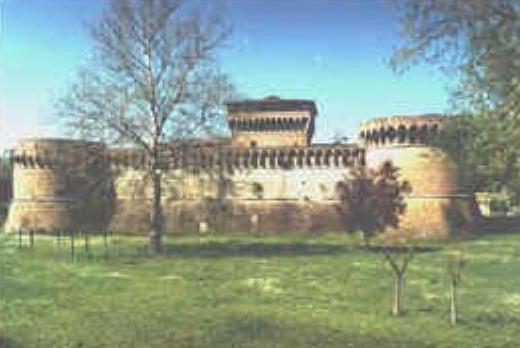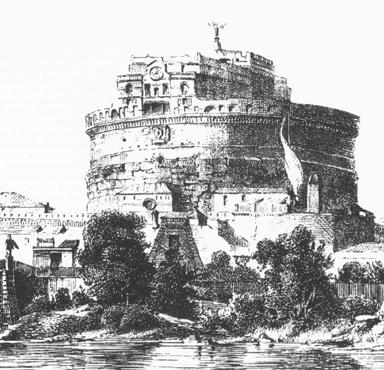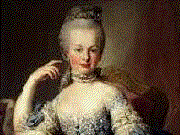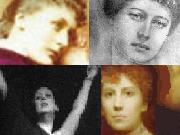Womania
| Caterina Sforza |
| Table of Contents |
Books on eBay ???
Why not!
Click the picture below!
Enter the BOOKS category and
Find fun and bargains!

 Fortress of Ravaldino |
Caterina fought like a “Tigress”.
Taking advantage of her depressed mood at the time of morning over her deceased husband, Venice demanded that Forlì give free passages for its troops against Florence. But the “Tigress” refused. Venice advanced, nevertheless, on the fringe of Forlì. Thereupon, Caterina set up her defence, reinforcing arms and supervising horses by herself along the border. Thus she formed the most effective bulwark against the Venetian policy of expansion. Thanks to this courageous woman, Florence could draw a deep breath.
At the beginning of 1499, with Caterina’s earnest and persistent request to Pope Alexander VI, her second-oldest son Cesare eventually became Archbishop of Pisa.
However, to her surprise, Caterina learned that this same pope had decided to make his own son, Cesare, the ruler of the whole region in Romagna, including her cities—Forlì and Imola. She tried to make him reconsider his decision by sending long-neglected taxes to the pope, who simply refused to accept the payment and drove away her envoy.
Finally, it all became so clear to her eyes that the Pope now wanted not the money, but the entire Romagna. He wanted to place his own son in the seat of Caterina, driving away her and her family. Thus the Pope would establish the papal authority firmly in Forlì and Imola.
The Pope announced the war. Rimini, Pesaro, Camerino, Faenza and Urbino became all weak-kneed. However, Caterina determinedly stood against the Pope and, for that matter, whoever tried to remove her from Forlì and Imola. Since Florence and Milan were in the fight against France, Caterina could not ask for support from both powers. So she decided to train her own soldiers by herself.
From now on, her subjects saw daily at the drilling place, where Caterina prepared the infantry and cavalry for the forthcoming war. Thus the lady of Forlì and Imola turned the moderate defense into the best condition. In addition, she cleaned trees and houses so that her artillery men could have clear views to spot the enemy and to launch the cannon balls at the right target. Additional mercenaries were enlisted to strengthen the fortresses and purchased enough ammunition and weapons.
Before the papal, French, Swiss and German troops advanced, Caterina had sent her children to Florence for safety. Most people except Caterina believed that she had hardly a chance to win against those armies of 15,000 soldiers. Even her subjects regarded this war as a sheer suicidal attempt of their desperate lady. Therefore, when Cesare and his troops approached Imola and then Forlì, they opened their city gates.
Nevertheless, Caterina and her 900 soldiers remained firmly in the fortress Ravaldino. When he reached the fortress, Cesare tried to negotiate with Caterina, who refused to listen—let alone to surrender. Finding no other choice, Cesare started to fire at the fortress on December 28, 1499. The heavy artillery damaged the walls. Caterina’s men had to repair them at night with stones-and-sand-filled barrels.
Though she fought back bravely, Caterina did not have a chance to push back the overwhelming force, nor did the armies show up to help her from Milan—let alone from the Holy Empire. Her uncle, Il Moro, had already fled to Germany. Although her sister was a wife of the Holy Roman Emperor, Maximilian had teamed up with the Pope. Unlike at the Orsi revolt, Caterina was doomed at this time.
On January 12, 1500, the enemy seized the fortress.
Wounded she was handed over Cesare, who allegedly raped her several times in the shank. He remained in his room alone with Caterina—now, the prisoner of war—for the night and the next day. All the historical records remained silent regarding her response to Cesare’s behaviors during this period of defeat. We only know that Cesare, twelve years her junior, had been attracted to this brave woman in her sensual prime.
Cesare was known to have obtained whatever he had wanted to have. This policy of his applied not only to his ambition to expand the region under his power but also to his desire for beautiful women. However, nobody knew for sure what had really happened behind the closed door in his room.
In February 1500 Caterina was transferred to Rome. Although she gave up her fortresses, she refused to resign without her rule in Forlì and Imola. She was not a mere prisoner since she had not abdicated yet. Besides, technically, she was not Cesare’s prisoner because she was captured by a certain French captain. According to the French law, a woman could not be held prisoner of war.
Therefore, instead of being thrown into the dungeon, she was accommodated in the Belvedere palace and guarded by twenty soldiers. She still lived like the lady of Forlì and Imola.
 Castel Sant’Angelo sketched in the 15th century |
On May 26, 1500, however, after she had failed to flee, Caterina was dragged finally into the dungeon of Castel Sant’Angelo. They said, “Once thrown down the dungeon in the castle of Sant’Angelo, nobody could get out alive.”
No doubt Caterina sank into the depth of distress. No visitors except rats amused her in her cell surrounded by the damp walls. The air smelled filthy with the stinking body odors of the other prisoners. Yet Caterina remained firm with her refusal of abdication.
Her sons, Ottaviano and Cesare, wrote her to give up since they were no longer interested in ruling Forlì and Imola. On the contrary, they hoped to receive from the Pope clerical offices or high positions within the church.
On June 30, 1501, Caterina gave up her resistance and signed the deeds of abdication. After her release, Caterina first stayed in the Palace of her nephew Rafaello Riario, the cardinal of San Giorgio. Meanwhile, Caterina met her step-sons from her marriage to Girolamo. They did not possess the smallest interest in acquiring titles over any territory. Her oldest son Ottaviano, who turned twenty-two and remained egoistic, wished to have the cardinal hat, which he would not be able to receive. Eventually in 1508 he became the bishop of Volterra and Viterbo. Her second-oldest son, Cesare, had been already appointed the archbishop of Pisa.
GIovanni—Caterina’s Youngest and Favorite Son
By all means, however, Caterina wanted to see her three-year-old son Giovanni who lived in Florence with his uncle Lorenzo de’Medici—brother of her third husband (not Lorenzo the Magnificent). Therefore, she set out to the hometown of her late husband. As soon as she arrived, Caterina got involved in the bitter legal arguments with her brother-in-law, who refused to hand over the property at the mansion Castello, which had been bequeathed to her in the will by her late husband. Only after three years settled down the problem and Caterina moved into the mansion with Giovanni.
Then Lorenzo wanted to take away her youngest son from her hands since, he claimed, he still retained the custody for the child. Caterina realized that Lorenzo had already embezzled the large amount of money left by her late husband, and feared that, to obtain a large part of the remainder of the inheritance, Lorenzo might kidnap her son. Therefore, in 1504, Caterina placed her six-year-old son into the Annalena convent, where Giovanni stayed for eight months in girl’s clothes while studying at the convent school.
In June 1505, Caterina eventually gained the sole custody of her son. Lorenzo was obligated to return what he had embezzled ever since. Meanwhile, Giovanni grew into a Sforza youth who showed a great interest in weapons, horses and sports. Caterina was certainly proud of this son, who became so similar to her brave ancestors.
When she fell ill in April 1509 with a pleurisy, Caterina ordered in the will that her favorite son be placed after her death under the guardianship of the priest Fortunati, her old friend, and the banker Jacopo Salviati. She died on May 28, 1509, at the age of forty-six. In an inconspicuous modesty, she was buried in the church of the Murate without an epitaph.
Even at eleven, Govanni looked like an athletic condottiere, resembling his famous Sforza ancestors. One chronicler recorded that he had already attacked the first bandit. At twelve, he had visited for the first time a brothel and had killed the first ruffian. Within a few years, he became the most successful and most daring condottiere.
In 1516 his relative Pope Leo X gave him command of a troop. He soon established a great reputation as a military leader. His nickname—Giovanni dalle Bande Nere or Giovanni of the black bands—was probably acquired because of the black stripes of mourning on his banners after the death of Leo X in 1521.
In the Italian Wars, Giovanni fought (1521–22) in northern Italy for the pope, on the side of Holy Roman Emperor Charles V, against Francis I of France.
In 1525, however, Giovanni changed sides, and fought with Francis in the battle of Pavia, where he was severely wounded. In 1526 he again sided with Francis, fighting for the League of Cognac.
 |
| Cosimo (Grand Duke of Tuscany) built a mausoleum in memory of his father Giovanni de’ Medici in San Lorenzo, the Medicis’ memorial place. Cosimo wanted a monument worthy of the greatest military leader of the 16th century. |
Though the operation seemed successful, gangrene had already set in. After all, the painful operation could not save his life. At the age of only twenty-eight, Giovanni died on November 30, 1526.
Giovanni possessed great courage and tactical ability. His hold over his men was remarkable, and his corps remained together long after his death. His wife, Maria Salviati, was a grand-daughter of Lorenzo de’ Medici (Lorenzo the Magnificent).
In 1569, his only son Cosimo (1519-1574) ascended the throne as Grand Duke of Tuscany. Through her descendants, the blood of Caterina Sforza have ever since spread over all European royal houses to such monarchs as Louis XIV of France, Charles II of England, George I of England, Victoria of England, emperor Wilhelm II, and even Elizabeth II of England. Juan Carlo of Spain and his wife as well as Harald of Norway should also be able to call themselves as her ancestors.
 Wann read more stories about the Renaissance women?
Wann read more stories about the Renaissance women?
You might find interesting the following colorful women.
- Mary Barrett
Mona Lisa has been a mystery ever since Leonardo da Vinch painted it. There is no concrete evidence. Besides, the portrait that the scientist believes to be Caterina Sforza is debatable. Some art historians doubt its authenticity. If you want to know more about it, please visit this page: Who was Mona Lisa?
- Akira
| Copyright Akira Kato About this author:
|

|
|
|||||||


























